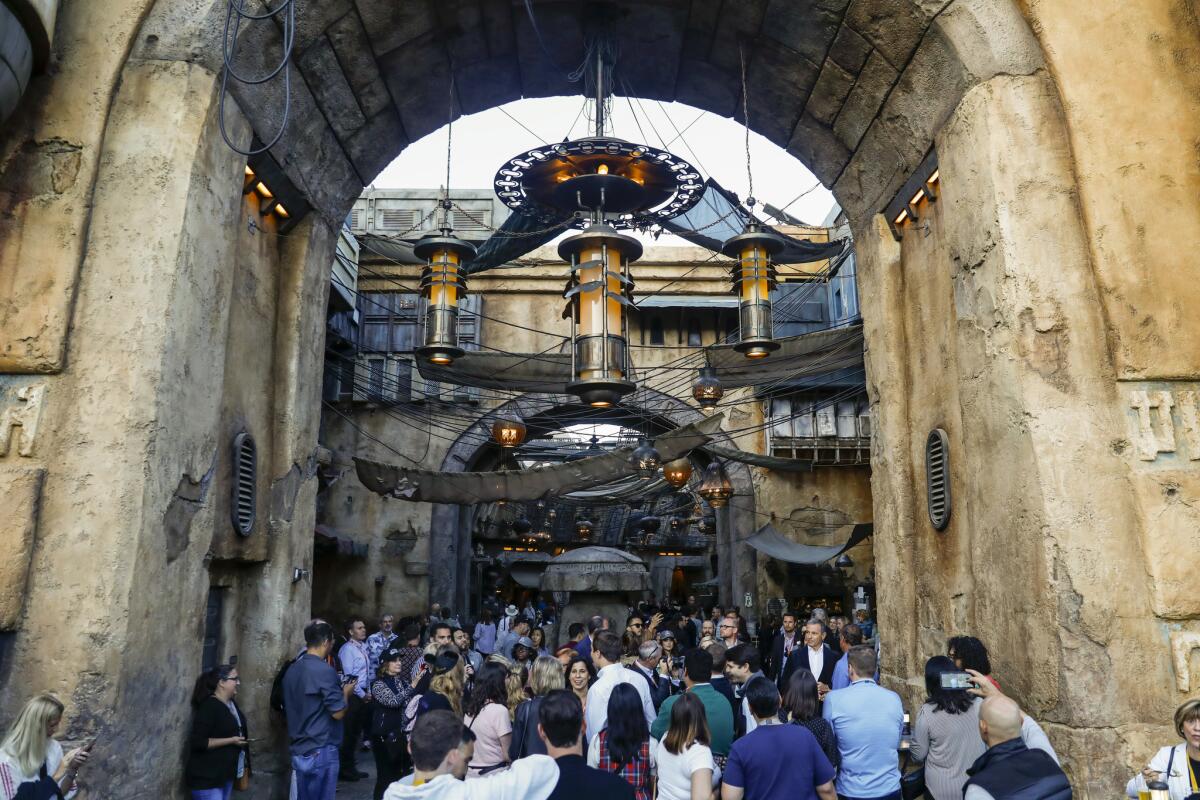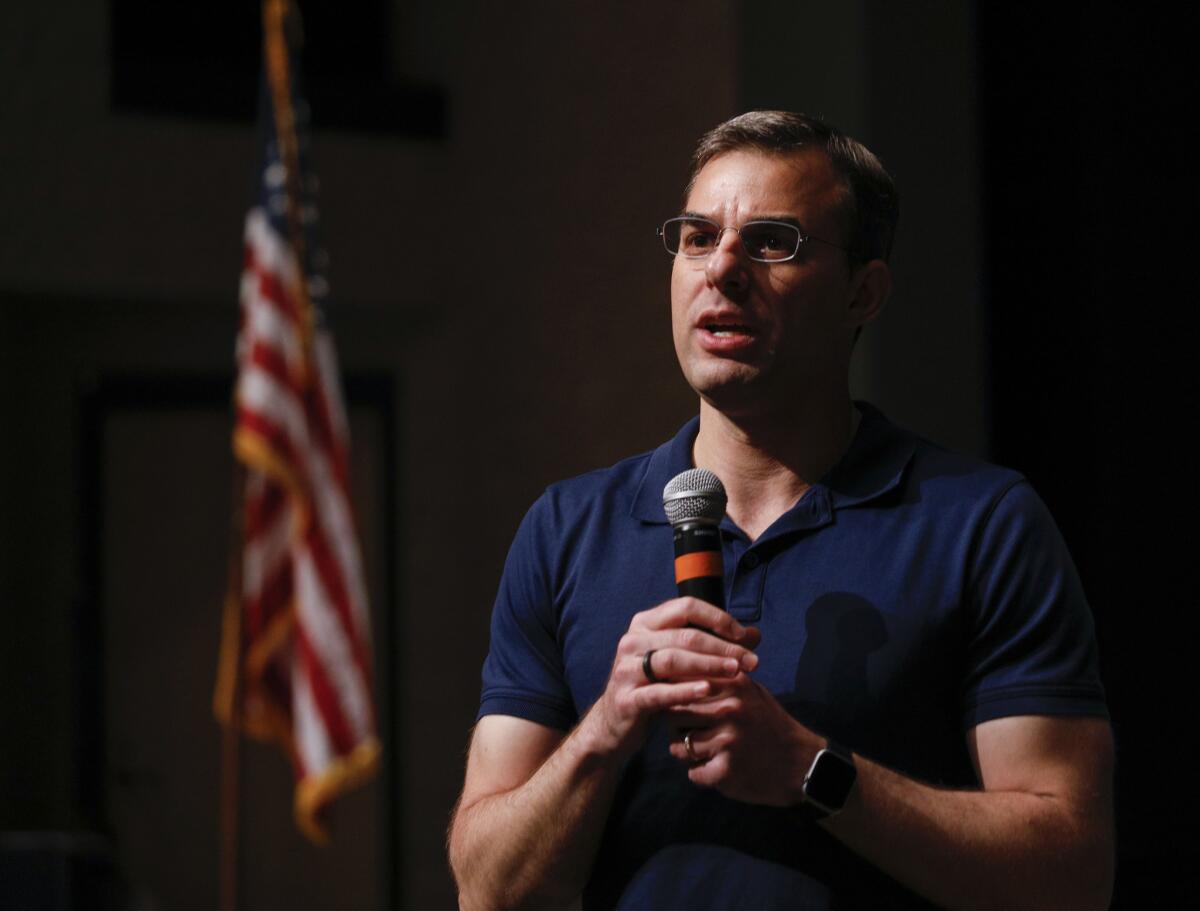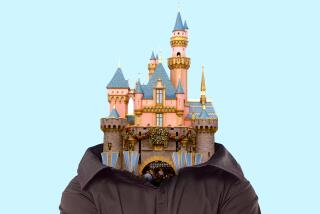From ‘Aladdin’ to Galaxy’s Edge, how Hollywood interprets Arab culture

- Share via
The city walls are scarred with bullet holes and burn marks. Tattered camouflage netting hangs like moss over defunct fighter posts and the Moorish archways of the marketplace. The cries of hungry children fill the bazaar, where merchants in flowing robes and headscarves hawk scarce, overpriced goods to desperate parents.
It’s a war zone I recognize, or at least one I think I recognize as an Iraqi American and someone who has taken more family trips in combat-wrecked regions than poolside resorts.
But despite the multiple checkpoints, nomadic desert garb and food staples of hummus and pita, this is one Arabesque war zone where you won’t hear Saudis flying American fighter jets overhead or see the black flags of Islamic State crumpled on the ground.
You may, however, spot a fairy princess or three smothered in layers of pink taffeta, adults wielding $200 toy lightsabers and “locals” addressing “travelers” with jargon that as many have pointed out sounds as if it were pulled straight out of a “Handmaid’s Tale” episode. “Bright suns!”
“Under his eye” is not the correct response, I learn, but it won’t get you kicked out of Star Wars: Galaxy’s Edge, Disneyland’s new theme park inside a theme park.
The 14-acre immersive experience is designed to transport guests from the old-timey shops of Main Street to the Black Spire Outpost on the planet of Batuu, “a remote trading port for smugglers, traders, and adventurers traveling the Outer Rim and Wild Space.”
Where does a politician fit into the recent uptick in images of flying carpets, magic lamps and domed souks?
Translation: It’s a wonderland for fans of the film franchise, many of whom cried when they stepped foot in the “port” on opening day two weeks ago. But for those of us who know little about fictional resistance beyond that being waged in Gilead, it’s a costly journey to an artfully distressed realm where the entry fee is equal to a transcontinental plane ticket and price-gouging has driven the cost of a small bottle of Coke to nearly $5 (just like Baghdad!).
Galaxy’s Edge, like “Star Wars” creator George Lucas, was inspired by Islamic architecture, nomadic desert life and cultural markers throughout the Middle East. It borrows from the rugged terrain of Tunisia and Jordan, the chaos of war-torn areas stretching from Sanaa to Gaza and the romance of an exotic Arabia concocted in the backlots of old Hollywood.

ALSO: Never have TV viewers seen such contrast in Muslim images after New Zealand’s attacks »
In Magic Kingdom schematics, it’s the mouse-ears version of the Persian Gulf, just as the American South is New Orleans Square, Europe is all over Fantasyland (a castle, the Matterhorn, lederhosen, turkey drumsticks fit for a king), the West is Frontierland and yesterday’s idea of future is here today in Tomorrowland.
The world of sheiks, sand dunes and never-ending conflicts, however, is trickier to navigate than, say, rockets and submarine rides without running into the unpleasantries of the real world.
Take Disney’s other recent venture, “Aladdin.” The film, released last month, is a live-action remake of the animated classic featuring Robin Williams. The new Genie, Will Smith, stars alongside an ethnically representative cast of Arabs, Coptic Egyptians, South Asians and more. In addition, several aspects of the story were updated to avoid the barbarous, hook-nosed stereotypes of the original.
And this time around the movie’s villainous, turbaned Jafar (Marwan Kenzari) is just as hunky as its Westernized hero, Aladdin (Mena Massoud). Take that, Indiana Jones, whose foes always seemed to be swarthier than his allies. Side note: The “Indiana Jones Adventure” ride is just a few checkpoints and churro stands from Galaxy’s Edge.
Some corners of the Arab and Muslim community felt the revamped “Aladdin” was still too Orientalist and inauthentic, despite the fact that the story is derived from a fictional tale written by a Frenchman about a place that never existed outside his own imagination. Despite the criticisms and lukewarm film reviews, the risky undertaking has rekindled a love affair with genie pants, DJ Khaled and turquoise blue.
Disney isn’t the only entertainment or media enterprise now playing with imagery and concepts from countries across the Mideast and North Africa.
Egyptian American Ramy Youssef, the stand-up comedian who made Muslim-centric humor the new avocado toast for millennials, drops his anticipated stand-up special on HBO later this month.
“Ramy Youssef: Feelings” follows the success of his breakthrough Hulu sitcom, “Ramy,” where he dramatized his experience growing up in New Jersey into comedic, half-hour episodes that tackled dating while Muslim, terrorism, immigration and racial profiling.
ALSO: Ramy Youssef on making TV’s first Muslim American sitcom, Hulu’s millennial comedy ‘Ramy’ »
Some of those very same themes that make audiences laugh in his forthcoming special, however, are being used by others to discredit U.S. Rep. Justin Amash of Michigan.
Where does a politician fit into the recent uptick in images of flying carpets, magic lamps and domed souks? After the release of the Mueller report, he was the only Republican member of Congress to publicly call out President Trump for engaging in “impeachable conduct.” His Palestinian ethnicity was called into question by critics in his own party — clearly his judgment was clouded by his otherness, just like Democratic Rep. Rashida Tlaib, also a Palestinian. There’s a connection!

In Galaxy’s Edge terms, Amash was being characterized as siding with the wrong side, i.e. Kylo Ren and his Nazi-like sycophants, members of the First Order. Though, it must be noted, Amash’s ancestors undoubtedly dressed more like the scarf-wrapped Rey than the stiff-collared villains.
Stormtroopers regularly march through Galaxy’s Edge like an occupying force, past shops selling tunics and signage in the common dialect of Aurebesh.
Pronounced Aa-rab-esh, it resembles Arabic, if Arabic was dropped in a blender with Hebrew, my son’s physics homework and a bag of pretzel sticks.
It’s a convincingly complicated-looking language that might easily pass as the dangerous “chatter” terrorism experts were so fixated on across cable news in the 2000s until they finally figured out it was an actual language spoken across continents.
Lucas, however, named Luke Skywalker’s home planet, Tatooine, after the Tunisian town of Tataouine, a spot in North Africa he reportedly fell in love with. It’s no wonder we’d later see Tusken Raiders dressed like Bedouins, or Jabba the Hutt puffing on something that looked a lot like a hookah.
Disney representatives reportedly said that Black Spire’s marketplace was fashioned after a souk in Istanbul, and it’s easy to see the resemblance while walking under the brass, filigreed lamps, through the merchant stalls and down the outposts’s winding alleyways. There’s even a seedy underbelly: Dok-Ondar’s Den of Antiquities. The shop, which sells state-of-the-art lightsabers, could pass as a black-market arms dealership or a clearing house for looted goods. It feels wonderfully illicit, and that’s OK.
The Middle East, with all its charms and flaws, is a complicated, fascinating mess of a place, and we’re finally starting to see its myriad angles reflected across an impossibly wide array of entertainment. It’s a shift that’s not lost on the folks who live in the very places that have dazzled the most jaded of Hollywood directors.
A few years ago while I was in United Arab Emirates, I took a drive three or more hours into the vast desert outside Abu Dhabi, a place called the Empty Quarter where “The Force Awakens” had just wrapped up filming. Sand dunes as high as skyscrapers towered above us, and we had to keep scarves wrapped around our faces like Tusken Raiders to keep the sand out. My Emirati guide beamed with pride that the Rub’ al Khali desert where he’d grown up was to star in what would surely be one of the biggest films of the year. Arabs had finally become an accepted part of the pop culture they consumed.
Galaxy’s Edge isn’t a love song to the Middle East, but it is a playful take on a region that’s too often written off as simply troubled and dangerous. If only the people who represent the region weren’t labeled troubled and dangerous when it serves the larger narrative. Meanwhile, I’ll take Arab culture as a theme park driver rather than a scare tactic any day, even if it means embracing faux war scars and mediocre hummus as part of the package.
More to Read
The complete guide to home viewing
Get Screen Gab for everything about the TV shows and streaming movies everyone’s talking about.
You may occasionally receive promotional content from the Los Angeles Times.







